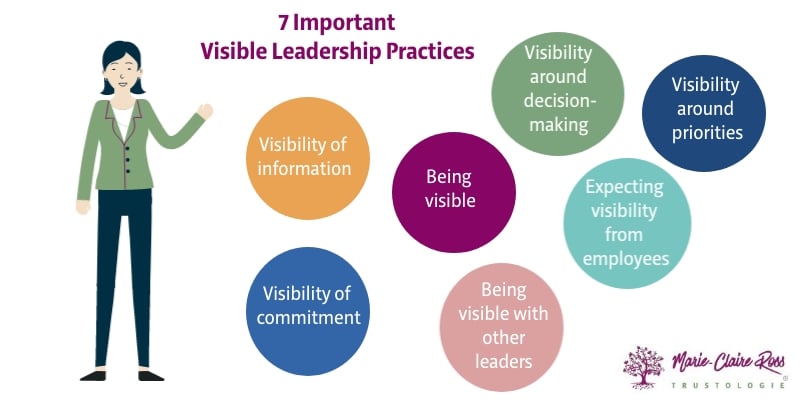
4 Mistakes You're Accidentally Making with Leadership Visibility
Imagine a workplace in dim light. Employees can't see one another properly or what work is being done. People become fearful, hold back from committing to their full potential and distrust the situation. Greed, corruption, conflict and poor accountability become the norm because people go into self-protection mode when they don't know what's going on. A lack of visibility tacitly enables poor leadership and employee behaviours to run rampant.
Visibility in the workplace is critical for building trust. That's why it's a key factor in my Integrated Trust Building System.
100.png?width=2835&name=The%20Integrated%20Trust%20Building%20System%20(colour)100.png)
Visibility requires shining a light in lots of different directions.
In my work with companies, I have found that there are six areas where leaders need to improve visibility in an organisation: visibility of information, visibility of decision-making, leaders being visible, visibility of priorities & accountabilities, employees being visible and leaders working visibly with other leaders. It's a lot to juggle.
But the payoff is huge because one of the biggest complaints employees make about their organisation is a lack of leadership visibility. What's interesting is that even companies that are proud of their transparency and openness make unintended mistakes.
Let's go through the biggest ones I see (intentional pun 😊).
1. The grumpy 'hello'
Employees love it when their leader acknowledges and greets them in the morning. Being seen is so important to us. It seems like a simple thing - but it has the biggest impact on an employee's day.
A lot of well-meaning leaders make a heart-felt effort to greet their employees. But they often make a terrible mistake. They greet people when they're stressed or grumpy. So their greeting comes across as terse. Worse still, is when they say 'hello' without eye contact or their voice sounds angry. Seems harmless, but I find most employees start to freak out.
As one employee said to me recently, "The other day my boss must have been having a bad morning. He greeted me, but he sounded angry and avoided eye contact. I spent the whole day worried I did the wrong thing. Was it something I said in my last email to them? Did I do something that caused a problem? I am sure it was more to do with the fact he had some other issue to deal with, I know he's really busy, but I couldn't get it out of my head."
2. Avoiding other leaders
We often think that leadership visibility is all about employees seeing their leaders at the workplace. But it's not just their boss they want to see. Employees are always observing leaders for signals on how to behave. One thing they do look out for are signs that top leaders are getting along. This is an interesting one and it's more about perception rather than reality.
In one organisation I worked for, employees complained that executives didn't trust one another. As far as they could see, issues would happen in their team that were caused by a bottleneck with another team. Their leader would say she would talk to the other team leader, but they couldn't see anything being done. Interestingly, team leaders would sort things out privately - not realising that their employees assumed it was because they didn't like each other!
What actually worked was for the leader to make a bit of a song and dance that they were going to get on the phone and fix up the issue with the other leader. This all had to be done in a way that demonstrated they were on friendly terms. Any whiff of the leader bagging out the other leader or not even saying anything was seen as a lack of trust between the two.
The trick here is to always demonstrate that you work well with other leaders to avoid any misperceptions that can damage leadership team credibility. This requires both leaders to be on board with working things out publicly - in the spirit of "let's fix this together.' Showing employees that you are both in alignment and keen to solve issues is paramount. And while you're at it - throw in a few laughs. That always relaxes employees that all is well!
3. Always being busy
This is a tricky one. So many leaders have to juggle lots of priorities and deadlines. But what's interesting is they don't realise that even when they work well with their teams and share information willingly, their busy-ness stop their employees from asking them questions or telling them about issues.
What employees will say is that "My boss has so much on his plate. I don't want to weigh him down with issues he doesn't need to know about. I like to protect his time and not add extra pressure."
You are probably wondering what this has to do about visibility. This one is more about being seen as always working hard and being frantic. It unintentionally can make leaders unapproachable.
The way to reverse this is to have open times during the day when people can talk to you about what's going on. Otherwise, your employees will avoid you or assume you are not there for them (which creates lots of trust and connection issues). Reassuring your people that you are there for them and demonstrating that consistently is important.
4. Being inconsistently consistent
Leadership visibility isn't easy, so many leaders try really hard to be transparent and approachable. What I often see is they might be really good at some forms of visibility - but only with certain stakeholders.
For example. Take a primary school where deputies greet students and parents at the school gate every morning, but fail to greet their teachers when they walk past them in the hallway. Seems inconsequential, but the teachers feel disconnected and not valued.
